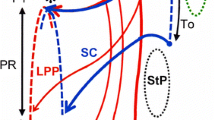Abstract
Two ligament systems of the larynx are demonstrated by dissection. The suspensory ligament of the esophagus is attached to the posterior aspect of the cricoid cartilage and is also a part of the fascial sheath which is common to the hyoid, thyroid, and cricoid. The ligaments at the inner margins of the vocal, ventricular, and aryepiglottic folds are distinctive in site and, inferentially, in function. The aryepiglottic ligaments join at the incisura between the arytenoid cartilages and are continued as the corniculopharyngeal ligament which splays into the flexible tissues in the anterior wall of the hypopharynx, posterior to the suspensory ligament of the esophagus. These ligament systems are involved in two different actions in swallow. The gross superior and anterior motions of the larynx are transmitted to the esophagus by the suspensory ligament, so that the esophagus is elevated in relation to the bolus and is also opened. These esophageal displacements resemble, in effect, the swallow displacements of the pharyngoesophageal segment and of the constrictor wall of the hypopharynx. The marginal ligaments of the laryngeal folds help to implement the constriction and closure of the larynx during swallow. By anatomical inference, the corniculopharyngeal ligament effects vertical traction within the flexible tissues of the anterior wall of the hypopharynx.
Similar content being viewed by others
References
Donner MW, Bosma JF, Robertson DL: Anatomy and physiology of the pharynx.Gastrointest Radiol 10:196–212, 1985
Bosma JF, Donner MW, Tanaka E, Robertson D: Anatomy of the pharynx, pertinent to swallowing.Dysphagia I:23–33, 1986
Lewis DD: The elastic tissue of the human larynx. Am J Anat 4:175–191, 1904
Williams PL, Warwick R:Gray's Anatomy, 36th ed. Philadelphia, W.B. Saunders, 1980
McVay CB:Anson and McVay Surgical Anatomy. Philadelphia, W.B. Saunders, 1984
Meschan I:An Atlas of Anatomy Basic to Radiology. Philadelphia, W.B. Saunders, 1975
Pernkopf E:Topographische Anatomie des Menschen, vol 3. Vienna, Urban and Schwartzenberg, 1952
Ardran GM, Kemp FH: Closure and opening of the larynx during swallowing.Br J Radiol 29:205–208, 1986
Kahrilas PJ, Dodds WJ, Dent J, Logemann JA, Shaker R: Upper esophageal sphincter function during deglutition.Gastroenterology 95:52–62, 1988
Jacob P, Kahrilas PJ, Logemann JA, Shah V, Ha T: Upper esophageal sphincter opening and modulation during swallowing.Gastroenterology 97:1469–1478, 1989
Cook IJ, Dodds WJ, Dantas RO, Massey B, Kern MK, Lang IM, Brasseur JG, Hogan WJ: Opening mechanisms of the human upper esophageal sphincter.Am J Physiol 257:G748-G759, 1989
Author information
Authors and Affiliations
Rights and permissions
About this article
Cite this article
Bosma, J.F., Bartner, H. Ligaments of the larynx and the adjacent pharynx and esophagus. Dysphagia 8, 23–28 (1993). https://doi.org/10.1007/BF01351474
Issue Date:
DOI: https://doi.org/10.1007/BF01351474




